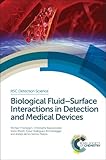Biological fluid-surface interactions in detection and medical devices / [Book] Michael Thompson, University of Toronto, Ontario, Canada, [and four others].
Material type: TextSeries: RSC detection science series ; No. 8.Description: xiv, 290 pages : illustrations ; 24 cmISBN:
TextSeries: RSC detection science series ; No. 8.Description: xiv, 290 pages : illustrations ; 24 cmISBN: - 9781782620976 (hardback)
- 1782620974
- Biological interfaces. -- Implants, Artificial--Biocompatibility
- Biomedical materials -- Biocompatibility. -- Biosensors
- Implants, Artificial -- Biocompatibility. -- Fouling -- Biomedical materials--Biocompatibility
- Biosensing Techniques -- instrumentation. -- Blood--Coagulation
- Biofouling -- prevention & control
- Surface Properties
- Body Fluids -- chemistry
- Biological interfaces
- Biomedical materials -- Biocompatibility
- Implants, Artificial -- Biocompatibility
- 541.33
- 541.33
| Item type | Current library | Call number | Status | Date due | Barcode | Item holds |
|---|---|---|---|---|---|---|
 Books
Books
|
Junaid Zaidi Library, COMSATS University Islamabad Ground Floor | 541.33 THO-B (Browse shelf(Opens below)) | Available | 56336 |
With development of implants and in vivo detection devices comes the complication of the interaction between the materials used in the devices and biological fluids. This book examines these interactions causing fouling in biosensors and the serious issue of thrombus formation. The chemistry of surface-protein and surface-cell interactions is considered, the coatings and strategies re the avoidance of fouling are compared and the expert contributors provide a comprehensive look at the physical chemistry of the implant surface and the fouling problem. Finishing with a discussion of the future for surface modified biosensors in point-of-care devices and microfluidic technologies, this book provides an important addition to the literature suitable for professional researchers in academia and industry and postgraduate students.
All


There are no comments on this title.